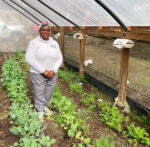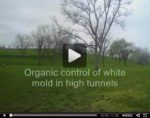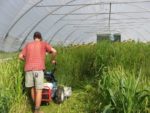The educational materials listed on this page are about High Tunnels or Hoop Houses.
A high tunnel or hoop house is a covered structure used to achieve season extension, or commercial fruit and vegetable production outside the usual growing season. Common vegetables to grow in high tunnels include tomatoes, peppers, leafy greens and lettuces, strawberries and brambles. Getting started with commercial hoop house farming requires a fairly modest investment in a structure, along with knowledge of high tunnel vegetable production, such as management of nutrients, pests, irrigation and temperature. Visit SARE’s High Tunnels and Other Season Extension Techniques topic room for detailed information on hoop house plans and hoop house construction, as well as other management topics. You can also find information about sustainable commercial greenhouse production in the High Tunnels and Other Season Extension Techniques topic room.
If you are interested in season extension through high tunnel farming or gardening, the resources on this page can help. Dig deeper for information on how to build a high tunnel or hoop house, how to manage vegetable and fruit production in one, and ideas for marketing.
Showing 1-4 of 4 results

Pest Exclusion Systems for Pest Management in Vegetable Production Across the Southeast
In organic vegetable production, and in situations where farmers are seeking to reduce chemical applications, Integrated Pest Management (IPM) strategies are recommended to exclude pests in both opens fields and in high tunnels. The principles of pest exclusion involve separating the insect pest from the host plant and protecting the crop at a specific growth stage. Careful planning of both materials selected and management design are important to keeping pests out of a cash crop. This bulletin provides data and information from on-farm demonstrations on the use of pest exclusion systems. Pest exclusion systems use shade cloths as a barrier around high tunnels, low tunnels and hoop houses to exclude insect pests.

Organic Control of White Mold in High Tunnels
The fungus Sclerotinia sclerotiorum infects many of the cool-season crops produced in Kentucky. This SARE-funded video presents information on the high tunnel production system most commonly used in Kentucky; the disease cycle of S. sclerotiorum; and two control tactics compatible with national organic standards, solarization and biofumigation.

High Tunnel Pest Exclusion System
Insect pests are one of the major problems in organic production systems. Organic IPM practice consists of a three-tiered approach consisting of systems-based practices, mechanical tactics, and biorational insecticides. Mechanical tactics encourage the use of physical barriers for pest exclusion. This bulletin provides preliminary research data and field observations about the success of shade cloths, or high tunnel pest exclusion (HTPE) systems, as a more permanent barrier system around the high tunnels.

Soil Management Using Cover Crops in Organically Managed High Tunnels
In southern climates, high tunnels are typically used for season extension in the spring, fall, and winter. In the hot summer months, if no shade cloth is used to cover high tunnels, it can be difficult to grow anything but the most heat tolerant crops, and it can be uncomfortable to work in tunnels due to the heat. This is an excellent time to incorporate a cover crop, between the late spring and early fall crops. Many cover crops species are adapted to hot southern summers and perform well in high tunnels.